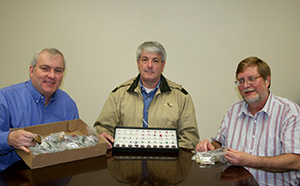
Greenwood physician Dr. Dan Robinson's hobby of collecting precious stones is paying dividends for Lander University.
Robinson recently presented Dr. David Slimmer, dean of the College of Science and Mathematics, with an assortment of stones that includes emeralds from Colombia, amethysts from Brazil, blue sapphires from Africa, lapis lazuli from Afghanistan and black spinel from Spain.
It's the fourth such gift that the Piedmont Health Group associate, a longtime resident of Greenwood, has conferred upon Lander. He hopes to do so again next year. "I plan on it being an annual event," he said.
A specialist in family medicine, Robinson has been collecting rocks since he was a boy. He sustains his hobby by buying and selling diamonds. "I enjoy it," he said. "It's fun."
Lander's latest haul also includes purple sapphires, pink tourmaline, green quartz, lemon citrine, aquamarine, diamonds, rubies, zoisite and tiger eye, from a variety of places around the world. Some are uncut, rough stones, and some are finished. All are clearly identified, making them excellent teaching tools.
Dr. Daniel Pardieck, associate professor of environmental geology at Lander, said that students in the geology, environmental science and other classes he teaches have "a lot of curiosity about what gemstones look like," and he enjoys being able to produce examples to show what he means.
Eventually, Slimmer would like to have a lighted display of precious stones on the first floor of the Science Building. In the meantime, he said, having specimens it can show students "supports the science department's mission of being hands-on."